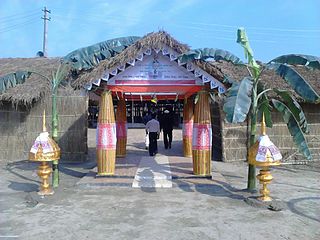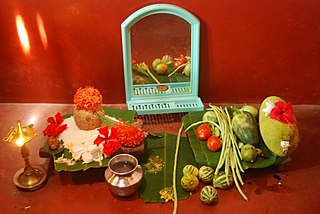
Assam is a state in northeastern India, south of the eastern Himalayas along the Brahmaputra and Barak River valleys. Assam covers an area of 78,438 km2 (30,285 sq mi). It is the second largest state in northeastern India by area and the largest in terms of population. The state is bordered by Bhutan and Arunachal Pradesh to the north; Nagaland and Manipur to the east; Meghalaya, Tripura, Mizoram and Bangladesh to the south; and West Bengal to the west via the Siliguri Corridor, a 22-kilometre-wide (14 mi) strip of land that connects the state to the rest of India. Assamese and Boro are the official languages of Assam. Meitei (Manipuri) is the official language of Hojai district and the entirety of the Barak Valley districts, while Bengali is an official language in the three districts of Barak Valley.

Nowruz is the Iranian or Persian New Year celebrated by various ethnic groups worldwide. It is a festival based on the spring equinox—which marks the first day of the new year in the Iranian Solar Hijri calendar, on or around 21 March on the Gregorian calendar.

Bihu is of three types and it is an important cultural festival unique to the Indian state of Assam – 'Rongali' or 'Bohag Bihu' observed in April, 'Kongali' or 'Kati Bihu' observed in October or November, and 'Bhogali' or 'Magh Bihu' observed in January. The festivals present an admixture of Tibeto-Barman, Austroasiatic and Indo-Aryan traditions entwined so intricately that it is impossible to separate them—festivals which are uniquely Assamese to which all communities of Assam had contributed elements. The Rongali Bihu is the most important of the three, celebrating spring festival. The Bhogali Bihu or the Magh Bihu is a harvest festival, with community feasts. The Kongali Bihu or the Kati Bihu is the sombre, thrifty one reflecting a season of short supplies and is an animistic festival.
Sankranti refers to the transmigration of the sun from one zodiac to another in Indian astronomy. In Saurmanavarsha, there are twelve Sankrantis corresponding with twelve months of a year. The Sankrantis can be broadly classified into four main categories: Ayan (Solstice), Vishuva (Equinox), Vishnupadi and Shadshitimukhi sankrantis.

The Bihu dance is an indigenous folk dance from the Indian state of Assam related to the Bihu festival and an important part of Assamese culture. Performed in a group, the Bihu dancers are usually young men and women, and the dancing style is characterized by brisk steps and rapid hand movements. The traditional costume of dancers is centered around the red color theme, signifying joy and vigour.

Mājuli or Majuli is a large river island located in Assam, India. It is formed by the Brahmaputra River to the south and east, the Subansiri River to the west and an anabranch of the Brahmaputra River called Kherkutia Xuti to the North.

The culture of Assam is traditionally a hybrid one, developed due to cultural assimilation of different ethno-cultural groups under various political-economic systems in different periods of its history.

Nobanno is a Bengali harvest celebration usually celebrated with food and dance and music in Bangladesh and in the Indian states of West Bengal, Tripura and Assam's Barak Valley. It is a festival of food; many local preparations of Bengali cuisine like pitha are cooked.

Bohag Bihu or Rongali Bihu also called Xaat Bihu is a traditional ethnic festival celebrated in the Northeastern Indian state of Assam and other parts of Northeastern India by the indigenous ethnic groups of Assam, and marks the beginning of the Assamese New Year. The festival is of mostly aboriginal origin comprising Tibeto-Burman and Tai elements. It usually falls in the 2nd week of April, historically signifying the time of harvest. Every year it falls on the 14th day of April. The holiday unites the different native communities of Assam regardless of their backgrounds and promotes the celebration of ethnic diversity.
Jonai is a subdivision of Dhemaji District in India's Assam State.
Kulajan Tiniali is a town in Dhemaji district in the Indian state of Assam. The town is situated on the northern bank of the Brahmaputra River, and is located approximately 493 kilometres from the city of Guwahati and just 13 km from Arunachal Pradesh. National Highway 15B starts at Kulajan and connects it to Dibrugarh.
Porag, also called Nara Singha Bihu, is a five-day long post-harvest festival observed by the Misings of Assam. Drummers and dancers belonging to a village are invited to perform in the neighboring village. It is a festival of songs and dances.

Folk dances of Assam include the Bihu and the Bagurumba, the Bhortal, the Ojapali dance. Assam is home to many groups: Muslim, Indo-Aryan, Rabha, Bodo, Dimasa, Karbi, Mising, Sonowal Kacharis, Mishmi and Tiwa (Lalung) etc. These cultures come together to create an Assamese culture. Residents of the state of Assam are known as "Axomiya" (Assamese). Most tribes have their own language, although Assamese is the primary language of the state.
Tirhuta Panchang is a calendar followed by the Maithili community of India and Nepal. This calendar is one of the many Hindu calendars. It is a tropical solar Hindu calendar in which the year begins on the first day of Baishakh month i.e. Mesh Sankranti. Every year, this day falls on 13/14 April of the Gregorian Calendar

The Mising people are a Sino-Tibetan ethnic group inhabiting mostly in the Northeast Indian states of Assam and Arunachal Pradesh. They are part of the greater Tani group of people of India and Tibet Autonomous Region of China.

Barechahariya Bhaona is a 200-year-old drama festival held every 5–6 years at Jamugurihat, a small town in Sonitpur District, Assam. The festival was first held in 1797-98. Led by Gayan Bora and sounds of Doba, Kanh, Bhortal and Khol resonates amidst the audience to signal the start of the Barechaharia Bhaowna. This tradition that dates back two centuries, livens up the small town of Jamugurihat.

Apo, apong, or poka is an alcohol drink commonly found among the tribes in the Northeast India states of Arunachal Pradesh and Assam. It is prepared by fermentation of rice. It is known by various names across different tribes in Arunachal Pradesh and Assam.
Lui Ngai Ni is the seed-sowing festival celebrated by the Naga tribes of Manipur India. The festival heralds the season of seed sowing and marks the start of the year for the Nagas and the festival was declared a state holiday since 1988.
Oi Nitom is a traditional music form of the Mising community of Assam. The Mising tribes consider this type of song as a folk song.

Bisu Parba is a new year and harvest festival of Tulunadu. It marks the first day of Paggu, which is the first month of Tulu calendar. It falls in the middle of April in the Gregorian calendar, on 14 or 15 April every year.












